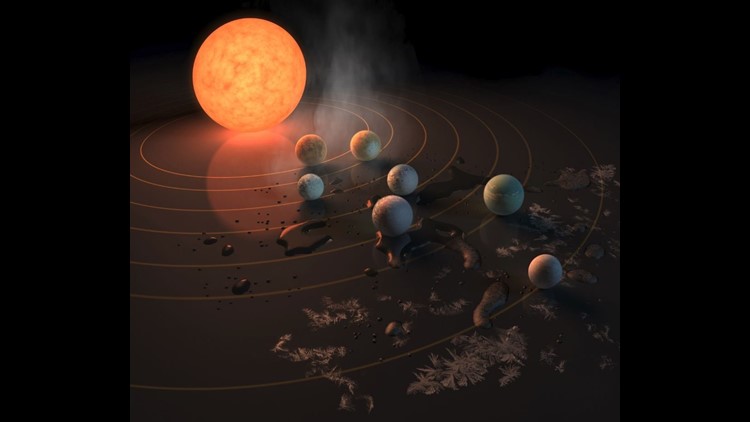Scientists have been anticipating the James Webb Space Telescope for years, and it’s set to launch in 2021. This large infrared telescope will be the premier observatory of the next decade, according to NASA.
While TESS, the planet-hunting satellite, has had a very busy first year seeking exoplanets — those outside our solar system — Webb will take a closer look at a selection of exoplanets to peer inside their atmospheres.
The planets TESS finds could be some candidates for a close-up look. But some that have already been discovered present intriguing findings just begging for further observation.
In February 2017, astronomers announced their discovery of seven Earth-size planets orbiting a star 40 light-years from Earth. The seven exoplanets were all found in tight formation around an ultracool dwarf star called TRAPPIST-1, and the planets bear the TRAPPIST name — which the researchers borrowed from their favorite beer.
Three of the planets are within the star’s habitable zone, where liquid water could collect on the surface of the planet and potentially support life.
Since that discovery, researchers have been trying to learn more about the potentially habitable planets. Now, a study suggests that the Webb Telescope could look for atmospheres around the TRAPPIST planets and study them during the first year of operations. The study was published Wednesday in The Astronomical Journal.
“The Webb telescope has been built, and we have an idea how it will operate,” said study author Jacob Lustig-Yaeger, a University of Washington doctoral student in astronomy. “We used computer modeling to determine the most efficient way to use the telescope to answer the most basic question we’ll want to ask, which is: Are there even atmospheres on these planets, or not?”
Determining whether the planets have atmospheres is the first step. Although they orbit an ultracool dwarf star, the planets weren’t always in such suitable conditions. The star is half the temperature and a tenth the mass of the sun. But it was much hotter earlier in its lifespan, which would have caused the nearby planets to lose atmosphere, oceans or ice.
“There is a big question in the field right now whether these planets even have atmospheres, especially the innermost planets,” Lustig-Yaeger said. “Once we have confirmed that there are atmospheres, then what can we learn about each planet’s atmosphere — the molecules that make it up?”
The researchers who discovered the TRAPPIST planets found them using the transit method. The team saw shadows, like little eclipses, periodically interrupting the steady pattern of starlight as they observed the star through a telescope. This is called transiting. The shadows indicated planets, and further observation confirmed it.
The same starlight used to detect planets passes through the planet’s atmosphere. When that happens, astronomers could detect the composition of the atmosphere, if it exists. This method also reveals colors representing different wavelengths of light.
“This happens because the gases in the planet’s atmosphere absorb light only at very specific colors,” Lustig-Yaeger said. “Since each gas has a unique ‘spectral fingerprint,’ we can identify them and begin to piece together the composition of the exoplanet’s atmosphere.”
And the Webb Telescope could sneak a peek at the potential atmospheres of all seven TRAPPIST planets in 10 transits or fewer using its Near-Infrared Spectrograph tool.
The only obstacle could be clouds in those potential atmospheres, which could mean at least 30 transits are required to make any detections.
“But that is still an achievable goal,” Lustig-Yaeger said. “It means that even in the case of realistic high-altitude clouds, the James Webb telescope will still be capable of detecting the presence of atmospheres — which before our paper was not known.”
The telescope may also be able to look for signs of water loss during the star’s hotter phase. That could lead to signs of oxygen, even if it isn’t the kind that is representative of life. But astronomers could rule out the false positive of the detection.
“By doing this study, we have looked at: What are the best-case scenarios for the James Webb Space Telescope? What is it going to be capable of doing? Because there are definitely going to be more Earth-sized planets found before it launches in 2021,” Lustig-Yaeger said. “It’s hard to conceive in theory of a planetary system better suited for James Webb than TRAPPIST-1.”



